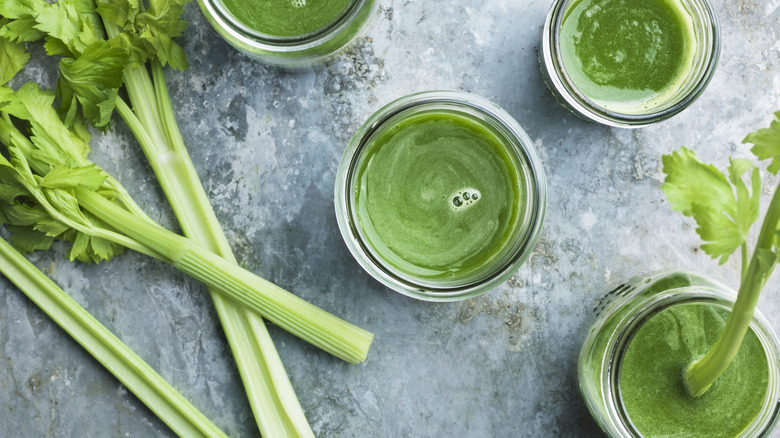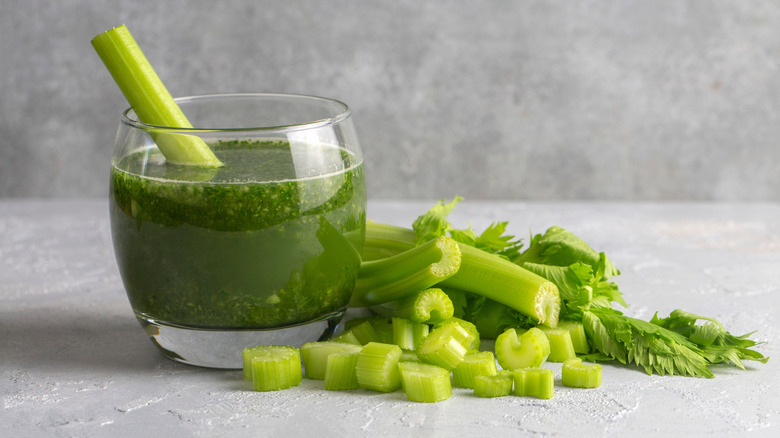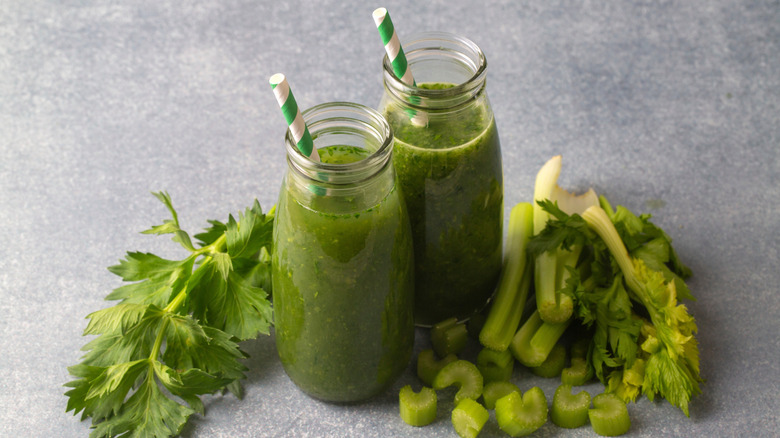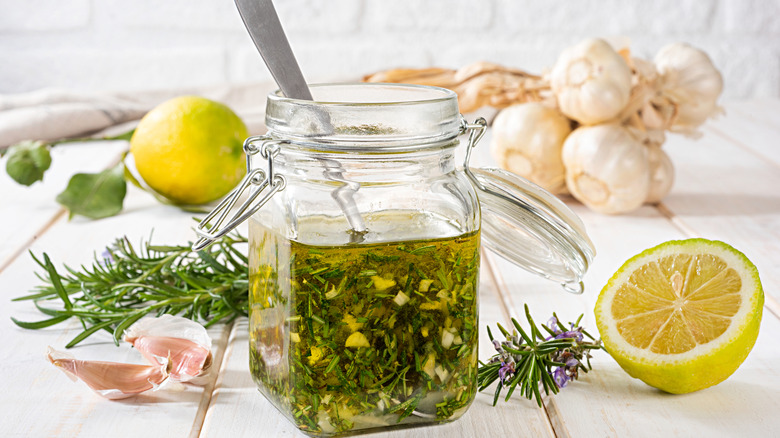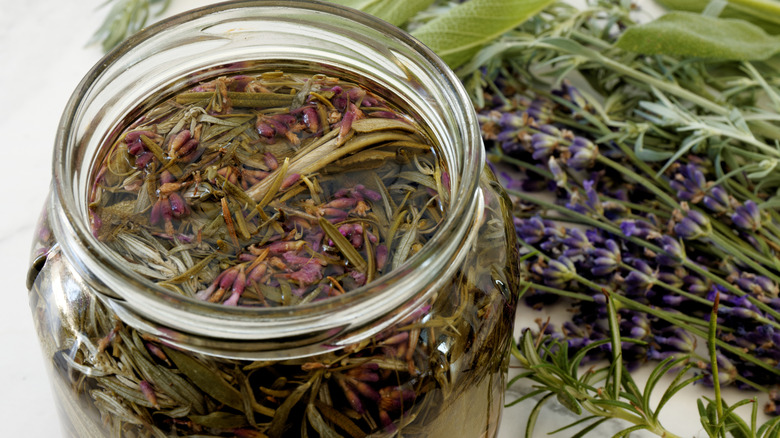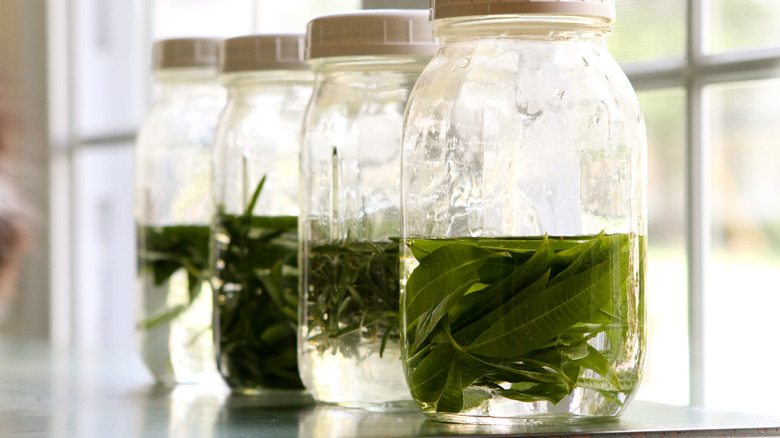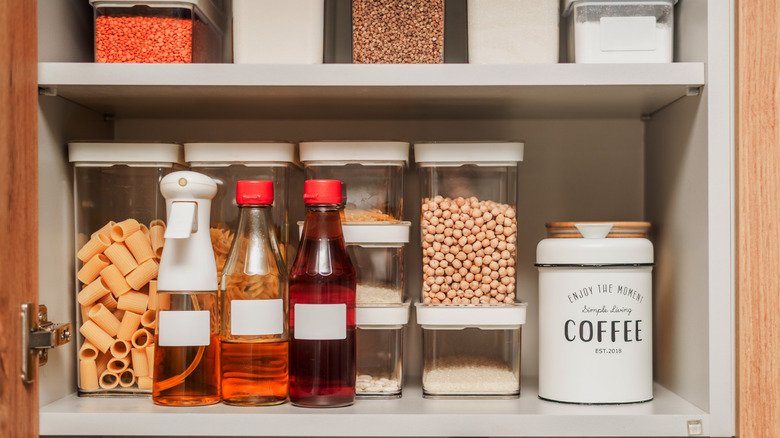Celery Vinegar Is The Secret To Brighter Sauces, Slaws, And Sweets
We may receive a commission on purchases made from links.
Most home cooks have a handful of vinegars in their pantries. From salad dressings and marinades to steak sauces and pickles, you probably have your favorite vinegars for any job on hand, ready to add a tangy twist to whatever needs a little something extra. But there's a strong chance your kitchen is missing one unique, unforgettable vinegar — celery vinegar.
Once a common condiment infused with celery seeds, celery vinegar has experienced something of a rebirth in recent years. This fermented vegetable vinegar adds a bright, herbal flavor and mild acidity to salads, slaws, roasted veggies, and more. Here's everything you need to know about celery vinegar, including how it's made, where to get it, and how to use it in your next dish.
What is celery vinegar?
Celery vinegar is a fermented vinegar made from blended whole celery or celery leaves. It's a raw, unpasteurized vinegar, naturally fermented using either cultured or wild yeast, much like apple cider vinegar, offering a fresh, mild vinegar flavor and even potential health benefits.
As for its uses, you can swap it in for any other vinegar in just about any culinary application, adding an herbal acidity to salads, dressings, oysters, and even cocktails. You aren't likely to find it at your local supermarket, but it's worth tracking down for its unique, artisanal flavor.
While celery vinegar may seem like a novelty today, it was a fairly common ingredient in kitchens in the 1800s, when it was made by infusing celery seeds in vinegar to extract the celery flavor. But today's fermented celery vinegars are a more modern innovation popularized by Noma, one of the world's most famous and highest-rated restaurants, in its 2022 guidebook, "Noma 2.0: Vegetable, Forest, Ocean."
How is celery vinegar made?
Celery vinegar can be fermented in several ways, and every producer has a slightly different method, but all of them start with blended or juiced celery. One method involves adding an existing vinegar mother — the rubbery probiotic disc that forms during fermentation — to the celery and allowing it to ferment. You can do this at home by adding a splash of raw, unfiltered apple cider vinegar to a celery slurry in a lidded glass jar and letting it ferment at room temperature until it tastes like vinegar.
Another way to make celery vinegar is to take advantage of wild ambient yeast, similar to making a fermented pickle. This is certainly the easiest way to make celery vinegar at home, since it requires no specialized equipment. All you have to do is blend or juice your celery, add some sugar for the wild yeast to feast on — around 60 grams per pint to achieve the standard 5% acidity of most grocery store vinegars — and cover it with a cloth to keep the dirt out and let the ambient yeast in. Then let it sit in a warm spot until it's fermented.
The third and most complex method comes to us from Noma itself, where the chefs begin by inoculating the celery mash with cultured yeast and distilled alcohol to give the yeast something to consume. After an initial fermentation period, the liquid is strained and boiled to kill the yeast, then fed an existing mother from a prior batch of vinegar. This mixture ferments for another 10 to 14 days, connected to an air pump and air stone to diffuse air into the mixture until it's ready to serve.
What does celery vinegar taste like?
Celery vinegar has a one-of-a-kind flavor that's definitely worth going out of your way for. It has a mild tang, smooth enough to enjoy as a drinking vinegar. Unlike some subpar flavored vinegars with added sugar and artificial flavors, the celery flavor takes center stage in fermented celery vinegar.
Its bright, herbaceous flavor is slightly sweet –much like apple cider vinegar — adding a delicious vibrancy to salads, roasted vegetables, and even raw oysters. Once you've had a taste of it, you may just find yourself reaching for it in place of your usual go-to vinegar for just about everything.
Where to buy celery vinegar
As eager as you may be to get your hands on some celery vinegar, you won't find this artisanal product at your neighborhood grocery store. While you may spot it at a local farmers market, your best bet is to order it online through specialty vinegar producers.
TART Vinegar produces a celery vinegar, but you'll have to be quick to get your hands on it. This vinegar is handmade in small batches out of the owner's Brooklyn kitchen in the Navy Yard, so it's only available seasonally and in very limited quantities. Another retailer, Häxan Ferments, also offers celery vinegar made through a traditional process — first wine, then vinegar — but, again, it's only available seasonally and often out of stock, as Häxan works directly with farmers local to its kitchen in the Pacific Northwest.
Keepwell Vinegar's celery leaf vinegar, made from the leaves of cutting leaf celery, is more readily available, but its first ingredient is apple cider, so it's not exactly the same as a more traditionally fermented celery vinegar. It will get the job done if you absolutely have to try celery vinegar in a hurry. But, if you really want to taste the real thing, you'll probably want to try your hand at making some yourself.
How to use celery vinegar
Celery vinegar is shockingly easy to use — just swap it in for your favorite vinegar in anything that could use a hint of celery. Use it to brighten up salad dressings, splash it on hot roasted veggies, or add it to your favorite marinade. It also shines anywhere you might use celery salt, like in potato salad. If you want to really show off your celery vinegar, you can splash it on raw oysters, or mix it with shallots and peppercorns to make a gorgeous mignonette, the quintessential way to garnish and serve oysters.
But perhaps the purest way to enjoy celery vinegar's unique flavor profile is to sip it. It imparts a colorful acidity to sodas, sparkling waters, and tonic-based cocktails with just a splash, or you can mix it with sugar and fruit to make a shrub perfect for sipping on a hot summer day.
Nutritional information about celery vinegar
Like most vinegars, celery vinegar has limited nutritional value, especially in the small quantities — usually a tablespoon or two — typically used. It has just a couple of calories per serving and, because the fermentation process consumes most of it, very little sugar.
But vinegars have long been used medicinally, and celery vinegar is likely to have similar health benefits to other raw, live vinegars and fermented foods. Some vinegars, most famously apple cider vinegar, have been said to treat stomach complaints, improve blood sugar regulation, ease respiratory illness, relieve pain, and heal and disinfect wounds. Though celery vinegar's health benefits have not been extensively studied, because it's made using the same traditional fermentation process as apple cider vinegar, and is often started using an ACV mother, it's likely to have similar effects.
Varieties of celery vinegar
There are two main types of celery vinegar — fermented vinegar made from the celery stalks and leaves, or infused vinegar made with celery leaves or seeds. Fermented celery vinegar is a relatively modern creation, which took off in recent years after Noma published its recipe. It takes a lot of time to produce, which makes it hard to find in stock at artisanal shops — and when you do, it's often pricey.
Infused celery vinegars, made by pouring distilled vinegar over crushed celery seeds, were popular in the 1800s. They're quicker to produce than fermented celery vinegar, taking less than 24 hours to brew. As a result, they're often easier to find and less expensive, though they will not have the same intense celery flavor as fermented celery vinegar.
You can find both versions, infused and fermented, in artisanal shops online, but the type may not be readily apparent at first glance. To be 100% certain, check the ingredients. If the first ingredient is celery, you've got a fermented vinegar, but if it's some kind of vinegar (like ACV), it's infused.
How to store celery vinegar
When you buy a bottle of celery vinegar, the label will probably instruct you to refrigerate it after opening, but this isn't strictly necessary. Like most vinegars, celery vinegar will not spoil, even at room temperature. Its high acidity and low sugar content — all the sugar having been consumed by the yeast in the fermentation process — make it a naturally inhospitable environment to the kinds of microbes that would lead to spoilage.
But because it's a live, raw vinegar, it will form its own mother if left unrefrigerated. This is completely natural and expected, and is immensely helpful if you intend to make your own vinegar at home, but some might find it a little bit unsightly. If you want to avoid that, pop it into the fridge after you've broken the seal. Otherwise, keep the cap on it and store it in the cabinet with your other vinegars.

